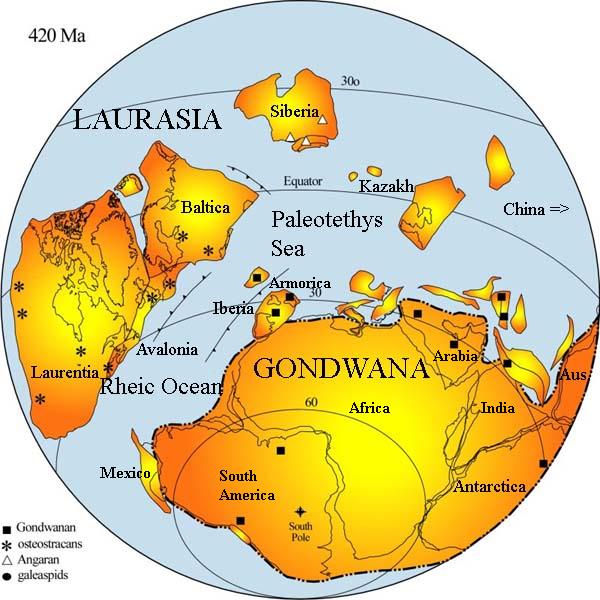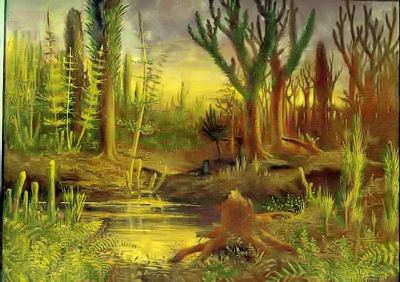The Lochkovian
The Lochkovian Age of the Early Devonian Epoch: 416 to 411 million years ago
The Geography of the Lochkovian Age
 Because of uncertainties about the timing of plate convergences, this particular globe looks much like the globe of the Ludlow Epoch of the Silurian. However a number of differences are well-documented. For example, by this time, the coalescence of Avalonia and Baltica with North America was complete and no trace remained of the Iapetus Ocean between Avalonia and Laurentia (North America). This did not mean that the geological effects of this collision were over. The Acadian Orogeny continued throughout the Devonian, making the Appalachian area a volcanically active region, and the Scandian Orogeny likewise affected Baltica in the early part of the Devonian.
Because of uncertainties about the timing of plate convergences, this particular globe looks much like the globe of the Ludlow Epoch of the Silurian. However a number of differences are well-documented. For example, by this time, the coalescence of Avalonia and Baltica with North America was complete and no trace remained of the Iapetus Ocean between Avalonia and Laurentia (North America). This did not mean that the geological effects of this collision were over. The Acadian Orogeny continued throughout the Devonian, making the Appalachian area a volcanically active region, and the Scandian Orogeny likewise affected Baltica in the early part of the Devonian.
Furthermore, the entire Laurasian landmass was beginning to move closer to Gondwana, a process which would later result in the formation of the world- continent of Pangea. However, during the Lochkovian, there was still some significant degree of separation -- not only between Laurasia and Gondwana, but also between Laurasia and Siberia, which was still north of the Equator.
The map shows how we know this. The Devonian is called the "Age of Fishes," and with good reason. The Devonian, and the Lochkovian in particular, is the first time when vertebrates become quite common in the fossil record. However which fishes we find in this Age depends on where we look. The Angaran faunal province of Siberia was characterized by amphiaspids and other profoundly derived Heterostraci. Laurasian waters were dominated by the Osteostraci, a very different group of jawless fishes. The Gondwanan fishes were different, yet again, and included galeaspids and gnathostomes.
Gnathostomes, fishes with jaws, are first found in numbers in the Ludlow or Pridoli of China, located on the long Sino-Australian peninsula on the other side of Gondwana. By Lochkovian times, gnathostomes were making an important contribution to the fish populations of South China, and were rapidly expanding southward through Australia and Antarctica into the cooler waters of the Gondwanan mainland.
The point of all this is that the different fish communities were endemic. That is, they were restricted to particular geographical regions. The most logical explanation is that significant ocean barriers to movement remained between Siberia, Laurasia and Gondwana. The fishes of this age were able enough coastwise swimmers. But few, if any, were equipped to survive in the open ocean.
While Laurasia was drifting southward towards Gondwana, it was also turning counterclockwise, bringing the broad Southern peninsula of Laurentia (the southeastern United States) very rapidly toward South America and Mexico. Some believe that these terranes actually came in contact as early as the Lochkovian. On the North end of Laurasia, Siberia was continuing to drift toward Baltica and was rotating clockwise. This also accelerated the approach of these two terranes. Thus, at least by late Lochkovian or Emsian times, the faunal endemism of the various continents was beginning to break down.
The position of the Chinese plates is quite uncertain during the Lochkovian. South China, at least was probably close to Australia, if we may judge from the increasing pace at which Chinese fishes were emigrating southward. However, North China was apparently rather isolated at this point, and its location is unclear. Another point of contention is the state of Iberia and Armorica, i.e. Spain and France. According to some sources these miniterranes had split off Gondwana and were creating a sort of bridge from North Africa to Southern Baltica, separating the Rheic from the Paleotethys. Other authorities believe that the southern European plates were still attached to North African Gondwana at this time. However, there is general agreement that Greece, Italy and Turkey were still part of Gondwana and were located near the coast of Arabia. ATW030219
The Climate of the Lochkovian Age
Sea levels plunged at the end of the Pridoli and remained moderately low throughout the Lochkovian. Continental seas remained, but they were extremely shallow. After a hiatus in the Ludlow and Pridoli, carbon dioxide levels again began to drop, as oxygen rose. Thus, even very shallow waters tended to be reasonably well aerated, but the climate was generally cooler than it had been in earlier ages. ATW030219.
Life in the Lochkovian Age
 At this time the Appalachian province of marine invertebrates is limited to the relatively narrow and elongate marine seaway in eastern and south-eastern Laurentia (North America). Other marine areas belong to the extremely widespread Old World province. This fauna is for the most part quite distinct from that of Euramerica. Janvier (1996) reconstructs an Early Devonian fish fauna in the 'Chinese realm': the
400-million year-old fauna or the Bac Bun Formation of Vietnam Lochkovian-Pragian) as including: (1) the dipnomorph Youngolepis ; (2) the acanthodian Nostolepis. (3) lungfish; 4) antiarchs including Yunnanolepis, Chuchinolepis, and Vanchienolepis); and (5) galeaspids, including Polybranchiaspis and Bannhuanaspis). These fishes lived in coastal lagoons or shallow marine waters. in association with various marine invertebrates (e.g. brachiopods).
At this time the Appalachian province of marine invertebrates is limited to the relatively narrow and elongate marine seaway in eastern and south-eastern Laurentia (North America). Other marine areas belong to the extremely widespread Old World province. This fauna is for the most part quite distinct from that of Euramerica. Janvier (1996) reconstructs an Early Devonian fish fauna in the 'Chinese realm': the
400-million year-old fauna or the Bac Bun Formation of Vietnam Lochkovian-Pragian) as including: (1) the dipnomorph Youngolepis ; (2) the acanthodian Nostolepis. (3) lungfish; 4) antiarchs including Yunnanolepis, Chuchinolepis, and Vanchienolepis); and (5) galeaspids, including Polybranchiaspis and Bannhuanaspis). These fishes lived in coastal lagoons or shallow marine waters. in association with various marine invertebrates (e.g. brachiopods).
On land, along with the continuation of Cooksonia and Rhyniaphytes, the Lochkovian saw the appearance worldwide of two other types of simple pteridophyte. Zosterophyllum, like Cooksonia, had smooth axes containing a simple central bundle of tracheids, but its sporangia were attached to the sides of the axis (lateral rather than terminal) and were aggregated into a compact spike. The best-known examples of Zosterophyllum come from Euramerica, where it is thought that they lived, together with some rhyniophytes, on the dry shores of mountain lakes or on the banks of rivers running through plains nearer the sea. A period of diversification based on the Cooksonia and Zosterophyllum types of organization then followed, together with the first occurrences of Psilophyton. The finding of fossils preserved in various different ways has allowed the description of the internal anatomy of these plants, and this is used, together with the position of their sporangia, in the classification of these early, simple vascular plants (excluding the lycopsids) into three major groups, the rhyniophytes, the Zosterophyllophyta, and the Trimerophyta. Friday & Ingram 1985).
page uploaded on Palaeos Site 10 June 2002.
uploaded on Kheper Site on 14 June 2000)
Last modified ATW030220
checked ATW080113
page by
M. Alan Kazlev and Toby White
 Because of uncertainties about the timing of plate convergences, this particular globe looks much like the globe of the Ludlow Epoch of the Silurian. However a number of differences are well-documented. For example, by this time, the coalescence of Avalonia and Baltica with North America was complete and no trace remained of the Iapetus Ocean between Avalonia and Laurentia (North America). This did not mean that the geological effects of this collision were over. The Acadian Orogeny continued throughout the Devonian, making the Appalachian area a volcanically active region, and the Scandian Orogeny likewise affected Baltica in the early part of the Devonian.
Because of uncertainties about the timing of plate convergences, this particular globe looks much like the globe of the Ludlow Epoch of the Silurian. However a number of differences are well-documented. For example, by this time, the coalescence of Avalonia and Baltica with North America was complete and no trace remained of the Iapetus Ocean between Avalonia and Laurentia (North America). This did not mean that the geological effects of this collision were over. The Acadian Orogeny continued throughout the Devonian, making the Appalachian area a volcanically active region, and the Scandian Orogeny likewise affected Baltica in the early part of the Devonian. At this time the Appalachian province of marine invertebrates is limited to the relatively narrow and elongate marine seaway in eastern and south-eastern Laurentia (North America). Other marine areas belong to the extremely widespread Old World province. This fauna is for the most part quite distinct from that of
At this time the Appalachian province of marine invertebrates is limited to the relatively narrow and elongate marine seaway in eastern and south-eastern Laurentia (North America). Other marine areas belong to the extremely widespread Old World province. This fauna is for the most part quite distinct from that of